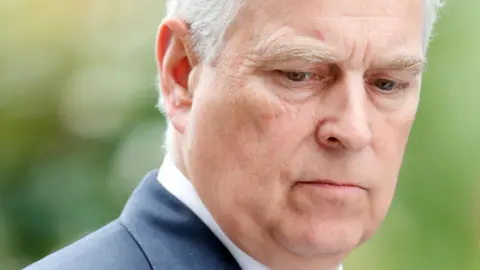Prince Andrew to pay costs or move out of Windsor mansion
 Getty Images
Getty ImagesThe Duke of York will have to pay his own costs for the upkeep and security of the Royal Lodge mansion in Windsor if he is to remain living there, the BBC understands.
Substantial subsidies from King Charles III and the Royal Family are not going to be available indefinitely for his accommodation in the 30-room house in Windsor Great Park.
Prince Andrew has a lease with the Crown Estate to stay in the house until 2078.
But it's suggested he has to be self-financing if he wants to fulfil the requirements to keep up the maintenance of the 19th Century listed building.
The pressure to move Prince Andrew, who lives in the house with his ex-wife Sarah Ferguson, has been called the "Siege of Royal Lodge".
And the sense of a prince under siege is likely to increase with a new Amazon film to be released next week about his 2019 Newsnight interview, which will re-ignite questions about his links to sex offender Jeffrey Epstein.
However sources suggest that moving out of Royal Lodge - perhaps to a smaller property such as Frogmore Cottage once used by the Duke and Duchess of Sussex - is about long-term financial pragmatism rather than family disagreements.
It's said that with Prince Andrew in his sixties there will be a plan needed for affordable accommodation for him in the future, not just now but in 10 or 20 years.
If he can privately fund the high costs of the maintenance and the security for a building on the grand scale of Royal Lodge, then he can remain, but if not then it seems that he will need to consider living elsewhere, as the current financial support from the King is not going to continue.
If the prince moved out, it's suggested that the historic Royal Lodge could be used as a commercial asset by the Crown Estate, rented in some way that would work with the security considerations of a house on the Windsor estate.
Prince Andrew's lease on the property began in August 2003 - in the year following the death of its previous occupant, Queen Elizabeth, the Queen Mother.
The prince had approached the Crown Estate about acquiring the lease - and renting it to Prince Andrew as a paying tenant was seen as financially preferable to using it as a "grace and favour" residence for the Royal Family.
 Amazon
AmazonThe house had been in need of renovation and the arrangement saw Prince Andrew taking on that initial cost, more than £7.5m at the time, rather than the Crown Estate having to pay for repairs.
He had also made a one-off payment of £1m to his landlords, the Crown Estate, the independent body that manages crown property, according to documents from the National Audit Office which examined the arrangements in 2005.
There was also the option of a one-off payment of £2.5m as a way of buying out the annual rental.
With its proximity to other royal residences, it was also thought that leasing it to Prince Andrew was a better arrangement in terms of security, rather than offering the house to the "wider market".
The 75-year lease agreement prevents Prince Andrew from gaining financially from any increase in the value of the house - and apart from the prince the lease can only be subsequently assigned to his daughters or his widow.
If Prince Andrew wants to terminate the lease, it will revert to the Crown Estate.
But there was a clause that if he left the house within 25 years of the start of the lease he would receive compensation for his original payment on repairs - with that amount shrinking each year.
With only four years left on that arrangement he would not stand to recoup much of the £7.5m he spent on renovating the house when he first moved in - with such a front-loading of costs making it less of an incentive for him to move out.
But more than 20 years after taking on the lease, the questions are now about the continuing costs of maintaining such a big property and paying for security - and whether Prince Andrew can afford it out of his own pocket.
There now seems to be increasingly public pressure for a more long-term solution for where the prince will live in the future.

Sign up here to get the latest royal stories and analysis straight to your inbox every week with our Royal Watch newsletter. Those outside the UK can sign up here.
